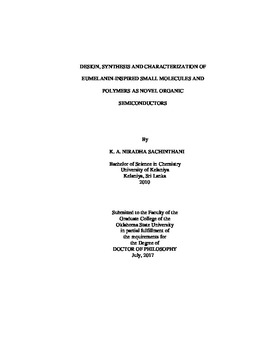| dc.contributor.advisor | Nelson, Toby L. | |
| dc.contributor.author | Sachinthani, K. A. Niradha | |
| dc.date.accessioned | 2018-06-25T13:38:31Z | |
| dc.date.available | 2018-06-25T13:38:31Z | |
| dc.date.issued | 2017-07 | |
| dc.identifier.uri | https://hdl.handle.net/11244/300267 | |
| dc.description.abstract | Over the past few decades, organic semiconductors (OSCs) have become a rapidly growing research field due to their diverse range of applications in electronics such as organic photovoltaics, organic light emitting diodes, organic field effect transistors, sensors and polymer batteries. These organic electronics offer several advantages over the conventional electronics because they are low-cost, flexible, optically transparent, light-weight and have low power consumption systems. Therefore, there is a high demand for high performance organic semiconductor materials. In the process of developing new OSCs, we have been inspired by materials that mother nature has created. One such nature's inspired material is Eumelanin, the major form of the natural pigment, Melanin. Melanin is found in all most all organisms and it is the primary determinant of the skin tone in humans. It is also found in hair, eyes, inner ears and brain of humans and acts as a photo-protective agent against the harmful radiation by converting it in to non-radiative pathways. Scientists have isolated natural eumelanin, a black-brown insoluble bio-macromolecule, from the ink sac of cuttlefish Sepia. It has been determined that the eumelanin is composed of two building blocks, 5,6-dihydroxyindole, and 5,6-dihydroxyindole-2-carboxylic acid, but the exact structure of the eumelanin remains unsolved. Recently, Meredith and coworkers groundbreaking work established eumelanin as an electronic-ionic conductor rather than an organic semiconductor which opens the door to many bioelectronics applications. However, the current synthetic eumelanin materials have poor solubility, produce thin, brittle films with poor morphologies and are not well-suited for analysis and fabrication of electronic devices. Therefore, synthesizing well-defined, soluble eumelanin-inspired material is significant. | |
| dc.description.abstract | In my research, the synthesis of eumelanin inspired core (DBI), which is similar to the building blocks of natural eumelanin, will be discussed first. Secondly, the utilization of this core to synthesize blue-emitting polymers for organic light emitting diodes (OLEDs), with optoelectronic, physical and electrogenerated chemiluminescence properties and as OLED device fabrication process will be reported. Finally, synthesis of eumelanin-inspired small molecules and polymers for the purpose of studying the structure-property-function relationships of natural eumelanin will be presented. | |
| dc.format | application/pdf | |
| dc.language | en_US | |
| dc.rights | Copyright is held by the author who has granted the Oklahoma State University Library the non-exclusive right to share this material in its institutional repository. Contact Digital Library Services at lib-dls@okstate.edu or 405-744-9161 for the permission policy on the use, reproduction or distribution of this material. | |
| dc.title | Design, synthesis and characterization of eumelanin-inspired small molecules and polymers as novel organic semiconductors | |
| dc.contributor.committeeMember | Bunce, Richard A. | |
| dc.contributor.committeeMember | Weaver, Jimmie D., III | |
| dc.contributor.committeeMember | White, Jeffery L. | |
| dc.contributor.committeeMember | Gappa-Fahlenkamp, Heather | |
| osu.filename | Sachinthani_okstate_0664D_15340.pdf | |
| osu.accesstype | Open Access | |
| dc.type.genre | Dissertation | |
| dc.type.material | Text | |
| thesis.degree.discipline | Chemistry | |
| thesis.degree.grantor | Oklahoma State University | |
